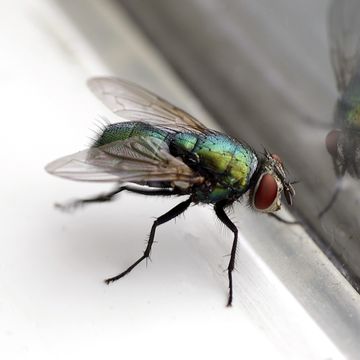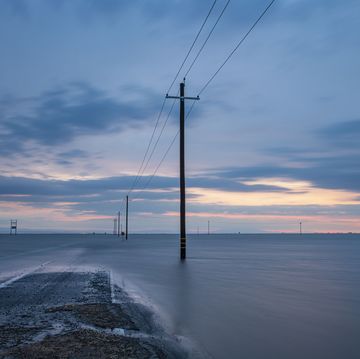If the goal of vacation is to feel better, why are nasty injuries, icky infections, and added pounds such common souvenirs? Why, when we travel, do we think we're in a parallel universe, where we have superhero powers and are immune from harm? With this ultimate Prevention trip planner, you'll have an excellent adventure...and still return in one piece.
BEFORE YOU LEAVE
Pack Your First Aid Kit
Pharmacist Laura Mandos of the University of the Sciences suggests:
Bandages and Neosporin: For cuts. For larger injuries, bring tape and gauze. If the water isn't safe, saline solution is a sterile wash.
Hydrocortisone cream: Provides topical relief for poison ivy, poison oak, or stinging nettles.
Benadryl: Good for allergic reactions—and in a pinch, it doubles as a sleep aid.
Imodium: Your go-to solution for diarrhea. (For an upset stomach, try ginger ale.)
Prescription meds: Pack extra, in case you get stranded.
Check Your Health Insurance
Not all medical insurance covers travel abroad. Break your leg while hiking in the jungle and a medical evacuation could set you back $10,000 or more. So ask your insurer about exclusions before you go, and consider buying a supplemental policy.[pagebreak]
GETTING THERE
On a Cruise
More than 50 million Americans planned to book a cruise between 2010 and 2013. And multitudes of stowaways—i.e., germs—will likely tag along. But despite the fact that cruise ship outbreaks of Norovirus, which causes stomach flu, have made headlines, hospitals, schools, and daycare centers are where 9 out of 10 such outbreaks actually occur. We hear more about episodes at sea because cruise lines are legally required to report outbreaks to the CDC. The organization also loosely monitors ship cleanliness and recently gave its top rating to 36 popular vessels, including Carnival Liberty, Norwegian Dawn, Celebrity Century, and Royal Caribbean's Freedom of the Seas.
On an Airplane
Whenever you're in a small, crowded place, you're at increased risk of contracting germs, says Mark Gendreau, MD, an air-travel expert and vice chair of emergency medicine at the Lahey Clinic in Burlington, MA. "Planes are often packed, and there's also the issue of the very low humidity level on aircraft," he says. "Your nasal membranes become dehydrated, which makes you more susceptible to infection from passing germs." Aside from the obvious precautions—drink lots of water, use saline nasal spray, and keep your hands off your face—he advises turning the overhead vent above your seat to medium flow and directing the nozzle slightly in front of your face. Then, if someone sneezes, those 30,000 airborne droplets are less likely to rain down on top of you. Also, if you have a choice, sit at the front of the plane, which typically has the best ventilation. Finally, bring along an alcohol-based hand sanitizer or antibacterial wipes to clean your hands, tray tables, and armrests, which can be teeming with germs.
60% of airplane food trays carry MRSA (Methicillin-Resistant Staphylococcus Aureus) bacteria. See 7 more germy public places to avoid.
(Leg) Room For Improvement
Tennis star Serena Williams is in top physical shape, so people were shocked when she developed a life-threatening pulmonary embolism after a long flight in February. But "it can happen to anybody who sits in a cramped space for a long time," says Arthur Agatston, MD, a preventive cardiologist and Prevention advisory board member. To keep clots from forming during long flights, periodically raise and lower your heels while seated and walk up and down the aisle a few times. If you feel calf pain when you flex and unflex your foot, call a doctor upon landing.
Have Radiation, Will Travel
Last winter, the traveling public was indignant—not about baggage fees but about radiation emitted by the Travel Security Administration's new Advanced Imaging Technology full-body scanners. The scoop: Although Americans' cumulative level of radiation exposure is now 7 times higher than it was 30 years ago, most of it comes from medical imaging tests. "Passengers get more exposure during a flight from cosmic radiation and solar flares than they do from airport scanners," says Dr. Gendreau.[pagebreak]
WHEN YOU ARRIVE
Get In The (Sleep) Zone
Between the hours you spent getting to the airport and the double time you put in at the office the week before, you're even more tired than you were before your vacation started. What's a sleep-deprived traveler to do? Graham Glass, MD, of the University of California, San Francisco Sleep Disorders Center, offers his tips to help you get your z's.
DO take melatonin. It's not a sleeping pill, but it helps reset your internal sleep clock. "If you're flying east, take it in the early evening before you leave on your trip; once you arrive, take another one an hour before bedtime," he says.
DON'T order a Bloody Mary on the plane the minute the beverage cart rolls by. We know, it's tempting—alcohol can help you to fall asleep despite your cramped upright position. But overall, drinking will disrupt your sleep and leave you less rested.
DON'T hit the sack as soon as you've checked in to your hotel—no matter how exhausted you feel. Instead, get on the local time. "There's a saying that 'heading east is a beast,' " says Dr. Glass. "If you must take a nap, keep it under two hours."
Get Out Your Sunscreen
Bathing suit: Check! Fully loaded Kindle: Check! Two bottles of sunscreen for every member of your family: Seriously? That's right. For adequate protection, you need to coat yourself every 2 hours and apply a lot more than you realize. Vanity alert: The thin skin on the top of your hands is a prime target for age spots. [pagebreak]
IN THE HOTEL ROOM
Sex On The Beach
Overworked couples often try to schedule morning, noon, and night sex on vacation to make up for lost time. Add to that the fact that people tend to be more sexually adventurous while traveling and you can have some unexpected mishaps.
A UK poll found that strained muscles took first place on the sex-accident index, followed by back injuries, sprained ankles and wrists, and the not-so-sexy battle scar known as rug burn. One in 10 said that they or their partner had fallen out of bed during sex.
Don't Let The Bedbugs Bite!
Bedbugs are equal-opportunity pests: You're as likely to encounter them at a high-end hotel as at a budget dive. To avoid forming a lasting relationship with these unwanted critters, follow these precautions from Missy Henriksen, vice president of public affairs at the National Pest Management Association:
Pestproof with plastic: When packing, pop clothes into giant sealable bags. There are also medium and large clear plastic suitcase covers for wary travelers who want to keep the bugs at bay.
Do a spot check: Upon arrival, deposit your luggage in the shower, and do a visual sweep for the apple-seed-size bugs (and specks of blood) on the mattress and upholstered furniture.
Safeguard your belongings: Even if your room is clean, keep your suitcase off the floor, preferably atop a hard luggage rack. Avoid draping your clothes over the furniture or placing them inside the dresser drawers.
Don't take them with you: As soon as you get home, launder all of your clothes—even items you haven't worn—on the hottest washer and dryer settings. Then vacuum your suitcase to suck up any stowaways.
More from Prevention: 7 Secrets to Staying Fit on the Road
[pagebreak]
EAT SMART
Beware Unwanted "Baggage"
Between grabbing a Cinnabon at the airport (730 calories!), slurping down one too many margaritas by the pool, and getting our "money's worth" at the buffet, many of us return from a weeklong trip 5 pounds heavier. Before you reach for the back-to-work caftan, put these three weight gain traps on your radar, says David Heber, MD, director of the UCLA Center for Human Nutrition:
Be wise about breakfast: Waffles and pancakes look tempting, but think of them as set decorations. Instead, greet the sunrise with a protein-rich shake or an egg-white omelet to kick-start your metabolism and keep you satisfied.
Count beverage calories: Cruise ships and all-inclusive resorts offer an endless supply of juices, sodas, and sweetened cocktails. By day, opt for green tea, which revs your metabolism. By night, drink red wine (125 calories versus 350 for a pina colada).
Say no nocturnal noshing: Where else but a cruise ship would you find Midnight Buffet extravaganzas? "No one should be eating from a towering chocolate fountain that late at night," says Dr. Heber.
Gut Reactions
You're not Andrew Zimmern of Bizarre Foods, so don't feel pressure to try the deep-fried scorpion, even if it's touted as the not-to-be-missed local specialty. If you're in a country where food safety is a concern, follow these three simple tips from the World Health Organization:
Run from raw: That includes undercooked eggs, leafy greens, produce without a peel or shell, and red meat and poultry whose juices run pink.
Beware the buffet: If cooked food has been sitting out for a while, do yourself a favor and don't eat it. The presence of steam is a good sign that food is hot enough. Cold food should be sitting on plenty of unmelted ice.
Turn off the tap: In addition, avoid raw milk, ice cubes, and ice cream. Bottled water is your safest bet. If tap water is your only option, bring it to a vigorous boil first. And never swallow water in the shower or from the sink—brush your teeth with the bottled stuff. [pagebreak]
GET BUSY
Take Your Fitness Routine On The Road
Layer up: Too cold for a morning walk on the beach? Merrell's Iso jacket is made from cutting-edge microfleece. It has 7 times more wind resistance than the regular kind. ($79; merrell.com)
Find an app: Whether your travels take you to Paris, France, or Portland, OR, mapmyrun.com has apps (iPhone, BlackBerry, and Android compatible) that let you chart a run, hike, or kayak trip.
Packable shoes: Skip the bulky sneakers and opt for New Balance Minimum Wellness featherlight walking shoes. They fold in half for easy packing. ($100; newbalance.com)
Bring your own mat: If you prefer your own germ-free yoga mat, Maduka's eKO SuperLite travel version weighs in at 2 pounds and folds into a compact cube. ($36; manduka.com)
Avoid Adventure Overload
Egged on by overzealous staff at hotel "activity" desks, many vacationers decide that now is the moment to take a maiden-voyage hang glide, do a daily 15-mile hike, or try the "2-hour deep-tissue sensory-deprivation massage," even though they're actually claustrophobic.
As a result, too many end up going home with not just cute local jewelry but also bills from a side trip to the local ER. Motor vehicle-related accidents (including ones that involve those adorable scooters you see zipping all over Italy) are by far the most common cause of injury and even death among travelers, and the risk is higher in developing countries where roads and traffic conditions are poor. Water-related activities are the second most hazardous. "Many vacation accidents happen because people overestimate their ability," says Peter Greenberg, CBS News travel editor. "They attempt black-diamond ski runs even though they're beginners."
Accidents happen, too, because travelers often fail to take basic precautions. "I don't tell people they shouldn't take adventure trips," says Greenberg. "But when you cross borders, you have to remember that all the basic rules still apply."
More from Prevention: No-Gain Guide to Vacation Dining











